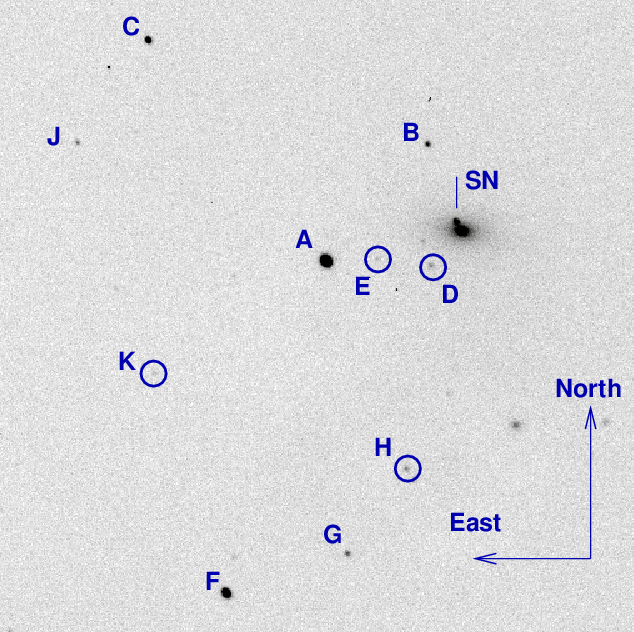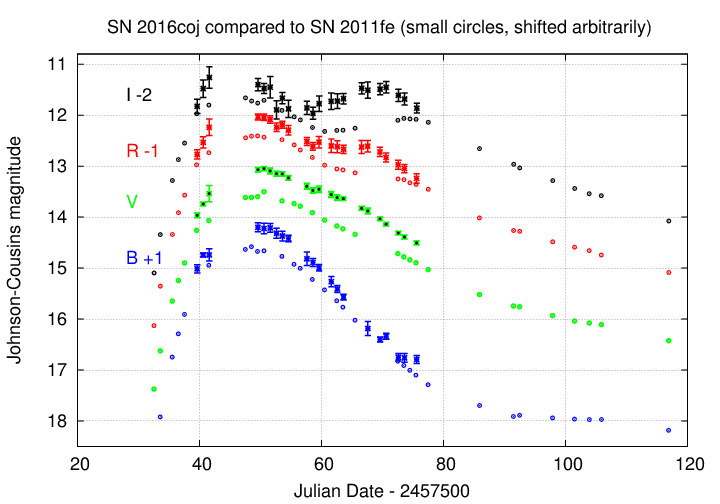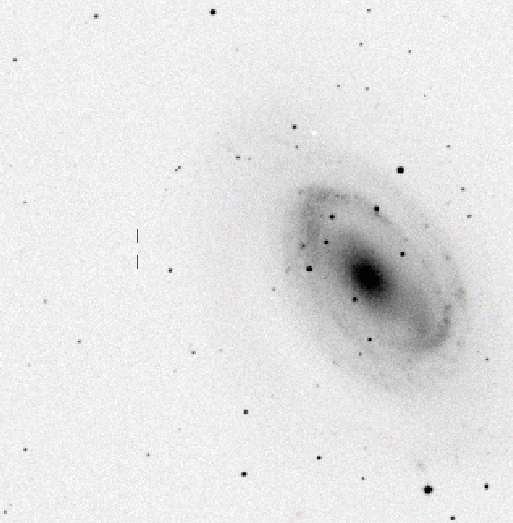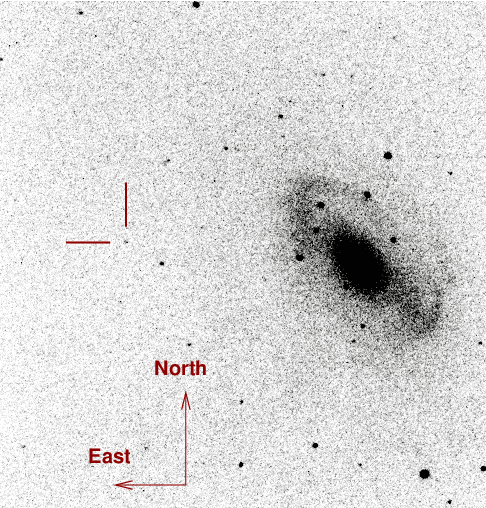
On the night of Jul 05/06, 2016, I observed SN 2016coj in NGC4125. When I heard that there might be a new, young supernova in the nearby galaxy NGC 4725, I took some images to confirm ... but later found out that it was just a minor planet. Rats.
The main setup was:
Notes from the night
SN 2016coj is a Type Ia supernova in the relatively nearby galaxy NGC4125. It was discovered by the KAIT group some time before maximum light:
NGC 4125 RA = 12:08:05.7 Dec = +65:10:30 (J2000)

The AAVSO sequence team kindly provided photometry for stars near this object. You can see their full photometric sequence on their website. Below, I show only the members of that sequence which fall into my very small field of view -- taken from AAVSO sequence X16288FJI. Note that star "K" is so faint that I may not detect it clearly in B-band.
letter B sigB V sigV R sigR I sigI ------------------------------------------------------------------------ B 15.198 0.086 14.133 0.052 13.627 0.116 13.155 0.156 C 13.317 0.093 12.673 0.058 12.316 0.121 11.980 0.161 J 15.607 0.109 14.956 0.065 14.603 0.136 14.271 0.182 K 16.573 0.123 15.975 0.082 15.547 0.174 15.147 0.231 -------------------------------------------------------------------------
In the continuing saga of the dark current, I again found that dark images taken immediately after twilight sky flats -- even if no flatfield images were saturated -- showed higher counts than dark images taken at other times.
I also noticed that some target frames of NGC 4125 show "ghost" images of Jupiter, on which I sync'd the telescope and focused some 20 minutes earlier. Sigh. I must be very careful not to expose important portions of the CCD to high light levels; or, if I do, I must allow some 30-60 minutes to pass so that the excess charge can gradually dissipate.
I took sets of 15-20 images in each filter, guiding in VRI, but not B. I used longer guide exposure times in I. I discarded any trailed images. I checked the focus before taking I-band images, but found no obvious evidence for a change.
As explained in the notes to Jun 14, 2016, I used the "rotsub" technique to remove the galaxy's light at the position of the SN.
On this night, I used "method 3", which means combining the individual images in a passband to make a master image, and then performing the "rotsub" technique.
Using aperture photometry with a radius of 4 pixels (radius of 5.5 arcsec) I measured the instrumental magnitudes of a number of reference stars and the target. Following the procedures outlined by Kent Honeycutt's article on inhomogeneous ensemble photometry, I used all stars available in each image to define a reference frame, and measured each star against this frame. I used the interim reference magnitudes above plus color terms which I am currently revising -- so please treat these results as preliminary to convert the ensemble instrumental magnitudes to the standard Johnson-Cousins BVRI scale.
Note that in the graph below, I combine data calibrated with UCAC4 photometry (first few weeks) with recent data calibrated with AAVSO photometry. That's inconsistent, and I'll re-compute all magnitudes later. Note further that I use only 2 AAVSO stars (B and C) for calibration, for consistency with earlier measurements; I'll use additional stars in my final calculations.
filter mag mag_uncert Julian Date
SN B = 15.795 +/- 0.077 (ens 0.072 zp 0.027) 2457575.61031
SN V = 14.506 +/- 0.036 (ens 0.034 zp 0.012) 2457575.60143
SN R = 14.240 +/- 0.093 (ens 0.032 zp 0.088) 2457575.59432
SN I = 13.862 +/- 0.097 (ens 0.039 zp 0.088) 2457575.63190
Below is a preliminary light curve, based on RIT Observatory measurements. I also show measurements of SN 2011fe in M101, an ordinary type Ia supernova, shifted arbitrarily.

During the day, I noticed that Astronomer's Telegram 9211 announced that ASASSN-16gu might be a young supernova in NGC 4725. Since that galaxy is relatively nearby, only about 13 Mpc away, this would be an unusual chance to see a supernova so close.
So, after acquiring images of SN 2016coj, I turned the telescope to NGC 4725 and took a series of images in BVRI. During the night, I couldn't tell if the images included any object at the reported position; that's not surprising, as the reported magnitude was about mag=17.
The next day, I had time to reduce the raw images and co-add 9 of the 30-second R-band frames. Compare below (on the left) a chart from the Digitized Sky Survey, with a pair of thin lines indicating the approximate position of ASASSN-16gu, and (on the right) my image from last night, the combination of 9 30-second R-band images.


Hooray! I did detect it!
However, this next morning, I found a message in my mailbox: Astronomer's Telegram 9214 explains that the object ASASSN-16gu was, in fact, the minor planet Makemake. D'oh!
Last night, while I was checking the pointing of the telescope, I used Stellarium to make a chart of the region. I recall that when I zoomed in on NGC 4725, I saw in blue letters the word "Makemake" floating nearby. At the time, I simply thought "Huh -- curious coincidence," but now I see that it was not a coincidence.
Oh, well. Better luck next time.
Last modified 07/06/2016 by MWR.